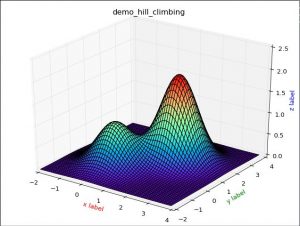利用nsga2进行进行特征选择其主要思想是:将子集的选择看作是一个搜索寻优问题(wrapper方法),生成不同的组合,对组合进行评价,再与其他的组合进行比较。这样就将子集的选择看作是一个是一个优化问题。
需要优化的两个目标为特征数和精度。
nsga2是一个多目标优化算法。
具体的nsga2通用算法请看:https://omegaxyz.com/2018/01/22/new_nsga2/
具体的特征选择代码在上述代码的基础上改了两个①主函数②评价函数,增加了一个数据分成训练集和测试集的函数:
|
1 2 3 4 5 6 7 8 9 10 11 12 13 14 15 16 17 18 19 20 21 22 23 24 |
function divide_datasets() load Parkinson.mat; dataMat=Parkinson_f; len=size(dataMat,1); %归一化 maxV = max(dataMat); minV = min(dataMat); range = maxV-minV; newdataMat = (dataMat-repmat(minV,[len,1]))./(repmat(range,[len,1])); Indices = crossvalind('Kfold', length(Parkinson_label), 10); site = find(Indices==1|Indices==2|Indices==3); train_F = newdataMat(site,:); train_L = Parkinson_label(site); site2 = find(Indices~=1&Indices~=2&Indices~=3); test_F = newdataMat(site2,:); test_L =Parkinson_label(site2); save train_F train_F; save train_L train_L; save test_F test_F; save test_L test_L; end %what doesn't kill you makes you stronger, stand a little taller,doesn't mean i'm over cause you're gonw. |
MATLAB代码主函数:
|
1 2 3 4 5 6 7 8 9 10 11 12 13 14 15 16 17 18 19 20 21 22 23 24 25 26 27 28 29 30 31 32 33 34 35 36 37 38 39 40 41 42 43 44 45 46 47 48 49 50 51 52 53 54 55 56 57 |
%%%%%%%%%%%%%%%%%%%%%%%%%%%%%%%%%%%%%%%%%%%%%%%%%%%%%% %此处可以更改 %更多机器学习内容请访问omegaxyz.com clc; clear; pop = 500; %种群数量 gen = 100; %迭代次数 M = 2; %目标数量 V = 22; %维度 min_range = zeros(1, V); %下界 max_range = ones(1,V); %上界 %%%%%%%%%%%%%%%%%%%%%%%%%%%%%%%%%%%%%%%%%%%%%%%%%%%%%% %特征选择 divide_datasets(); global answer answer=cell(M,3); global choice %选出的特征个数 choice=0.8; %%%%%%%%%%%%%%%%%%%%%%%%%%%%%%%%%%%%%%%%%%%%%%%%%%%%%% chromosome = initialize_variables(pop, M, V, min_range, max_range); chromosome = non_domination_sort_mod(chromosome, M, V); for i = 1 : gen pool = round(pop/2); tour = 2; parent_chromosome = tournament_selection(chromosome, pool, tour); mu = 20; mum = 20; offspring_chromosome = genetic_operator(parent_chromosome,M, V, mu, mum, min_range, max_range); [main_pop,~] = size(chromosome); [offspring_pop,~] = size(offspring_chromosome); clear temp intermediate_chromosome(1:main_pop,:) = chromosome; intermediate_chromosome(main_pop + 1 : main_pop + offspring_pop,1 : M+V) = offspring_chromosome; intermediate_chromosome = non_domination_sort_mod(intermediate_chromosome, M, V); chromosome = replace_chromosome(intermediate_chromosome, M, V, pop); if ~mod(i,100) clc; fprintf('%d generations completed\n',i); end end if M == 2 plot(chromosome(:,V + 1),chromosome(:,V + 2),'*'); xlabel('f_1'); ylabel('f_2'); title('Pareto Optimal Front'); elseif M == 3 plot3(chromosome(:,V + 1),chromosome(:,V + 2),chromosome(:,V + 3),'*'); xlabel('f_1'); ylabel('f_2'); zlabel('f_3'); title('Pareto Optimal Surface'); end |
评价函数(利用林志仁SVM进行训练):
|
1 2 3 4 5 6 7 8 9 10 11 12 13 14 15 16 17 18 19 20 21 22 23 24 25 |
function f = evaluate_objective(x, M, V, i) f = []; global answer global choice load train_F.mat; load train_L.mat; load test_F.mat; load test_L.mat; temp_x = x(1:V); inmodel = temp_x>choice;%%%%%设定恰当的阈值选择特征 f(1) = sum(inmodel(1,:)); answer(i,1)={f(1)}; model = libsvmtrain(train_L,train_F(:,inmodel), '-s 0 -t 2 -c 1.2 -g 2.8'); [predict_label, ~, ~] = libsvmpredict(test_L,test_F(:,inmodel),model,'-q'); error=0; for j=1:length(test_L) if(predict_label(j,1) ~= test_L(j,1)) error = error+1; end end error = error/length(test_L); f(2) = error; answer(i,2)={error}; answer(i,3)={inmodel}; end |
选的的数据集请从UCI上下载。
结果:
①pareto面

最后粒子的数据(选出的特征数和精确度)

PSO单目标特征选择请见:https://omegaxyz.com/2018/01/21/psofs/






求.mat文件
特征项为0的时候,错误率不应该是100%吗,为什么是25%
瞎猜有时候也能蒙对
运行主函数时出现这个情况:
输入参数的数目不足。
出错 evaluate_objective (line 12)
answer(i,1)={f(1)};
出错 initialize_variables (line 9)
f(i,V + 1:K) = evaluate_objective(f(i,:), M, V);
出错 nsga_2_optimization (line 18)
chromosome = initialize_variables(pop, M, V, min_range, max_range);
请问怎么解决,刚刚开始接触请大佬帮我解答一下!
我也遇到了同样的问题,希望大佬能帮忙解答一下,十分感谢
请问你解决了吗
请问添加了数据集后,运行出现这个错误:
未定义函数或变量 ‘Parkinson_f’。
出错 divide_datasets (line 3)
dataMat=Parkinson_f;
Parkinson_f没有定义,怎么修改
同问,你解决了吗?
请问initialize_variables函数没有更改吗?如果没有更改,f会出现问题。
可以试试随机初始化
大神,answer=cell(M,3);为啥要设为两行三列呢,3是什么含义呢,temp_x = x(1:V);这句话代表啥意思呢,f(1) = sum(inmodel(1,:));这个是特征的目标函数吗,为啥要求和呢,希望大神给予指导,我看好久了,实在不知道这几句为啥是这样的,还有就是把svmtrain和svmpredict换为其他网络时,如BP神经网络,子文件BPtrain的第一句应该怎么写呢,怎么调用都说输入参数不足。非常感谢大神能给予指导
你好,这个是多目标特征选择问题,有两个目标,其中一个是特征数,因此有一个是要求特征总和,如果要换成其他网络,请查看输入的接口,输入进分类器也就是你的BP是种群或者个体的编码也就是X值。
大佬,上面给的程序选择特征的个数是随机的,如果想要人为给定特征选择的个数范围,比如说在2到5之间,但最终得到的pareto前沿图只出现了个数为2或3的点,并不能显示出所有的点(如个数为4,5的点就缺失了),您知道为什么么?
抱歉,我不太清楚。
麻烦大佬给一下这个例子的所有代码可以么?(虽说是只有主函数和评价函数做了大的修改,其他nsga通用算法也会多少有一些变化)好人一生平安!好人一生平安!好人一生平安!
请问可以给一下Parkinson.mat文件吗?用自己下载的mat文件各种出错,感激不尽
评价函数中function f = evaluate_objective(x, M, V, i)的是输入的什么啊?因为在上个NSGA2代码里面,评价函数是function f = evaluate_objective(x, M, V),这里没有i,所以我有点不明白,还望老师指导一下,谢谢!!
x是当前个体,M是目标数量,V是维度,i是个体的标号,有时i是我作为控制变量的,有的时候可以不用。
明白了 非常感谢
能麻烦大神给一下你的Parkinson.mat文件吗?用自己下载的mat文件各种出错,感激不尽